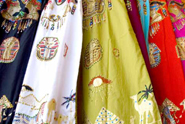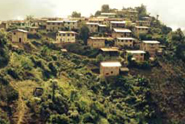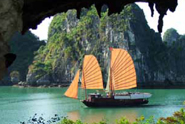Vietnam is now firmly on the world stage, but only since the early 1990s did travellers start arriving. Brilliant green rice fields stretch to the sun, bustling city streets where grand colonial buildings rub shoulders with gleaming new luxury hotels are everywhere, glorious mountain scenery with beautiful ethnic minority people, delicious cuisine, bustling markets, quiet temples and pagodas, and deserted beaches. This is Vietnam today.
Ho Chi Minh City (Saigon) is the commercial powerhouse of the country, with shiny new shopping malls, banks, international hotels, old markets, museums and a China town. Café life plays a major part in Vietnamese culture, and you will always find people enjoying coffee usually with sweet condensed milk and loads of ice (ca phe sua da) or black coffee with ice (ca phe den). There is even a new Starbucks! The Saigonese love to snack, and there are plenty of opportunities. The signature dish of Vietnam is Pho; a noodle based soup with either, chicken or beef. The dish is a cheap, healthy, nutritious meal with fresh herbs, onions, chilies, ginger, cinnamon, bean sprouts, fresh mint and much more. A day or two is probably sufficient to see the major attractions in Saigon, which really should include the Old Saigon Post Office, with its ornate façade and splendid interior, and the iconic Notre Dame Cathedral. Nearby is the former Presidential Palace.
For those with an interest in passed conflicts, a visit to the War Remnants Museum will give you a gruesome insight to the horrors of war (not for the feint hearted!).
Stroll down Dong Khoi Street to the Opera House and the colonial style Continental Hotel (as featured in the movie of Graham Greene`s “The Quiet American”. On the way, pass by the magnificent classical City Hall, all of which are easily accessible on foot. Further out of the city centre is the bustling China Town, known as Cholon. Here you will see Binh Tay Market, the largest market in Vietnam, and the Thien Hau Temple, with coils of incense creating a timeless atmosphere. Before leaving Saigon there are a number of interesting places to visit. One is the unique Cao Dai Great Temple where the religious sects practice Caodaiism and come together to worship in harmony. This can be done while visiting the famous Cu Chi Tunnels, an incredible underground network of tunnels on three different levels, constructed by the Vietnamese resistance fighters during their struggle for independence.
A trip to the Mekong Delta, either for one day or longer, is not to be missed. It will provide an unforgettable experience. Encompassing some 39,000 km2 this vast water world of paddy fields, orchards and fish farms is a labyrinth of canals threading their way between lush green islets and emerging into wide tumultuous rivers.
Discover the delta by boat and visit one of the early morning floating markets at which you can sample the local produce, coconut candy, a variety of exotic fresh fruit and the local rice wine. You can learn to understand the different beliefs among the Vietnamese, Chinese, Khmer and Cham people living in the region and even home stay in a local house and share the daily life of your hosts.
Travelling away from the frantic city of Saigon to the coastal city of Nha Trang will provide a complete contrast. This picturesque city in Central Vietnam on the shores of the East Sea is endowed with peace and quite all year round. Surrounded by islands, mountains and white sandy beaches, the warm climate and spectacular location make this an ideal tourist destination. Nha Trang Bay is considered one of the most beautiful bays in the world, with its clear waters and abundant coral reefs around the outlying islands a haven for divers of all skill levels. There are daily flights from Saigon that take less than one hour. However, the transfer from arrival at Cam Ranh Airport into the city can take as long as 30 minutes. Nha Trang is a very laid back city, and life mostly revolves around the beach. There are watersport centres, diving and snorkeling facilities and good restaurants. Cycling is the best way to see the countryside, as is often the case.
During the months of March and April, when the weather is very hot during the build up to the rainy season, the French Colonialists used to move to Dalat, a cool retreat in the central highlands. Here they developed a new town that has now become a big tourist spot. The journey by road from Nha Trang to Dalat takes about 4 hours, and snakes its way over mist shrouded mountains and through deep valleys. It is without doubt one of the most spectacular overland journeys in Vietnam. The town is set amongst lakes and pine forests, making it ideal for both mountain bike enthusiasts and hikers, as well as nature lovers.
From Saigon fly north to Danang, the third most “important” city in the country, and experience the ancient Cham civilisation. The city has the largest collection of Cham artifacts in the country, but as Danang does not offer much in the way of sites, most visitors travel on to the ancient port town of Hoi An.
Dating back to the 15th century, Hoi An`s eclectic mix of architectural styles stand testament to its illustrious past as a flourishing trading port. The town was, at various times, home to the Champa people, as well as Japanese, Dutch and Indian traders, who all brought their own individual cultures, which are reflected in the town’s rich heritage. Nowadays, Hoi An is a Mecca for tourists, who buy the colourful handmade lanterns, ceramics and textiles. Of particular interest are the 400-year old Japanese bridge with adjoining Buddhist pagoda, the merchant’s houses, and the market. There is an interesting Vietnamese cooking school in Hoi An, known as “The Red Bridge Cooking School”, for those interested in discovering the secrets of the local cuisine. Take the time to visit My Son, the former capital of the Champa people. Scattered throughout the lush green valley are many ancient towers dating from the 7th to the 13th centuries.
The coastal route from Hoi An to Hue is possibly one of the most scenic in the country. Just beyond Danang the road climbs over the Hai Van Pass, or Pass of Ocean Clouds. This is the highest pass in Vietnam and is also geographical and physical division between north and south. Finally, the road enters the ancient capital of Vietnam, Hue.
Hue was once the capital of the Nguyen Dynasty from 1802 to 1945, and the numerous architectural monuments reflect this rich cultural era that includes the impressive Citadel, recognised as a World Heritage site by UNESCO. This tranquil city lies on the banks of the Song Huong river, also known as the “Perfume River”. A boat trip along the river will unveil many historical treasures, including the Thien Mu pagoda (the official symbol of Hue) and the tombs of Minh Mang, Tu Duc and Khai Dinh.
Hue is renowned for its excellent cuisine, often spicy but fragrant with an assortment of dipping sauces. For a flavour of Hue cooking, try Ban Xeo, a delicious hot pancake filled with shrimp, pork slices, bean sprouts and herbs. It is accompanied with a fish sauce and carrot dipping sauce. Also, Banh Beo is a small steamed rice pancake with fresh savory toppings. Bun Bo Hue is a Hue style beef vermicelli dish. There are many variations on this recipe and all are delicious.
There are some excellent cooking schools in the city offering classes to aspiring chefs. It is possible to spend time living and working with the local farmers in nearby Tra Que Vegetable Village.
If time allows, drive north through the lush countryside to Bach Ma National Park. Stretching from the East Sea to the Laos border, this vast tract of wilderness is teeming with wildlife. If you can reach the summit of Back Ma Mountain, the reward will be a stunning panorama. In the far north lies the capital city of Vietnam, Hanoi, on the bank of the Hong River (Red River). To reach Hanoi there are regular flights from Hue and Danang. The city exudes a quiet charm, despite the traffic, with ochre-coloured colonial buildings, tree-lined
boulevards and large lakes. Hanoi demands that you spend time to savour and enjoy its 1,000- year old history. Home to the revered Ho Chi Minh, a visit to the Ho Chi Minh Mausoleum is essential, as well as a visit to Uncle Ho’s residence. Then, on to the lotus shaped One Pillar Pagoda, resting on a single stone pillar rising from a small lake, and to the Temple of Literature, Vietnam’s first University. The “Old Quarter” of the city provides an insight into the ancient trading practices in Hanoi, and retains the old street plan and architecture. The streets are named after each trade, such as silk, jewellery, cobblers and coffee. A tour through this fascinating area should be taken by cyclo, which is a three wheeled cycle rickshaw. At the end of the day, a visit to the Thang Long Water Puppet show is a must. Water puppetry is an ancient Vietnamese art form dating back to the 11th century depicting folk tales.
Take a break from city life and travel to Halong Bay, with its 3,000 spectacular limestone islands soaring dramatically from the emerald green waters of the bay. This World Heritage site is one of Vietnam’s gems. Stay for the day or overnight on a traditional wooden junk, exploring caves and the small isolated beaches. Relax on the sundeck, swim or kayak. The tranquility of the bay will leave you spellbound.
A two hour drive from Hanoi will bring you to Hoa Lu; the ancient capital and economic, political and cultural centre of the first centralised feudal state in Vietnam (from 968 to 1010BCE). From here it is a short drive to the Van Long ecotourism area; an area of outstanding natural beauty, surrounded by impressive limestone mountains. A two hour boat trip on a local sampan though the rice paddies to the famous Tam Coc Caves affords a glimpse into the pristine rural landscape. There is the opportunity to cycle along the narrow paths and visit some of the hamlets in the valley. For the curious and energetic, a visit to the Yen Tu Pagoda will test your stamina as you climb the seemingly countless steps.
There is an overnight train that leaves Hanoi for Lao Cai, arriving at 6:30am. Upon arrival, overland transport will take you to the misty hilltop town of Sapa, in the far northwest near the Chinese border. Sapa hangs like a jewel between the sky and the earth, overlooking the deep valleys of the Hoang Lien Mountains, where cascading rice terraces cling to precipitous hillsides. Here you can climb Mount Fan Si Pan, the highest peak in Southeast Asia, follow the paths of the local people beside the mountain streams, or hire a motorbike and explore the region in your own time.
This is home to the colourful ethnic minorities of Black H’mong, Red Dzao, Thai, Yeo, Tay and Flower H’mong. Visit the local markets of Bac Ha, Mung Khuong and Cao Son and admire the decorative costumes of the friendly ethnic people. There are few words that can fully describe the breathtaking beauty of this region. It is said that Sapa has four seasons in one day, and I can vouch for that. A word of caution: Sapa has now developed into a highly popular tourist destination and, as such, the ethnic people are now “business savvy” and tend to follow tourists everywhere with their wares. An unfortunate but inevitable side effect of mass tourism!
Useful Information On Vietnam Geography
Vietnam is bordered by China to the north, Laos and Cambodia to the west and the East Sea, well, to the east, which washes the shores of the long eastern coastal region extending some 3,260km north to south.
Climate
The seasons vary from the north to the south. Generally, the dry season in the north lasts from November to April and during this time the weather can be quite cold and damp. A good time to visit is between May and October. In the south, the rainy season starts around May and can extend to November (and sometimes into December). However, it doesn’t rain all the time. During these months the land becomes fresh and bright with the rice fields turning emerald green. The warm sunny days return in December and usually last until the onset of the rains in May.
People
Approximately 85 percent of the population are Viet Kinh. The remainder are ethnic Chinese, Chams, or members of the ethnic minority people who live in the central highlands and in the mountainous northern regions close to the border with China.
Language
Vietnamese is a tonal language that uses the Roman alphabet, and can be quite difficult for foreigners to master. Nowadays, English is widely understood and used, especially in tourist areas and hotels.
Religion
Buddhism is the most common religion in Vietnam. About 8 percent of the population are Catholic.
















